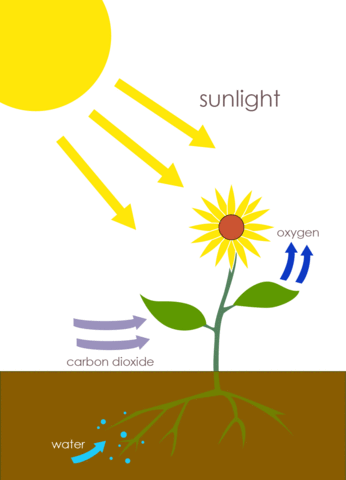Humans need food so our bodies can turn it into energy which fuels our everyday activities and growth, whereas plants create their own food through Photosynthesis.
This is the process where plants use carbon dioxide and water, then using light energy they are able to create glucose (a carbohydrate), and release oxygen as a waste product.
The word equation for photosynthesis is:
Carbon dioxide + water ![]() glucose + oxygen
glucose + oxygen
It can also be seen visually in the following diagram:

Photosynthesis Diagram by At09kg
We need plant's waste product (oxygen) in order to survive and they need ours (carbon dioxide). It's an amazing balancing act of nature that needs to be protected where possible, so let's be kind to our plants.
This is without doubt the easiest thing as a houseplant owner to get right. We simply don't do anything!
Despite Global Warming and increasing greenhouse emissions in the Earth's atmosphere which includes carbon dioxide, generally speaking there is a reasonably stable balance between Oxygen and Carbon Dioxide molecules. We just put our houseplant where we want it and it does all the work itself.
We play a significant part in this. Houseplants do not have natural access to water (unless they are placed in a very humid place such as a bathroom), so are dependent on us to remember to water them and when we do, do so correctly. No water means no hydrogen which in turn means no photosynthesis, too much water though and the plant dies.
Like water, our choices and actions regarding plant placement dictates how effective photosynthesis will be. If the plant is put in a very dark place no photosynthesis can take place, which means no fuel resulting in plant demise. Too much light and the leaves of the plant will fail, again resulting eventually in your plant dying.
Reading the above for a person new to houseplants might have them running for the hills, or at best pretty nervous about taking care of one. Admittedly the above sounds pretty grim if you don't get it spot on, but fortunately plants are adaptable.
t's true that different species will have different watering and lighting needs which can't be ignored constantly, but even then, most will still tolerate a relatively wide range of conditions.
To achieve success it's a simple case of looking up your particular plant, and finding out what it likes
To achieve success it's a simple case of looking up your particular plant, and finding out what it likes. Even if its not 100% perfect, most will forgive you, although you will have to accept the compromise of a slower growing plant or, perhaps if the case may be, fewer flowers.
When all conditions are good -photosynthesis takes place. Which in turns means you become a parent to a healthy growing/flowering houseplant. Congratulations!
The science behind the actual process is amazing, but arguably beyond the scope of this website. This is an excellent offsite article which provides you the basic workings of how it all happens without bogging you down with science.

Hi, I'm Tom!
If you're like me and enjoy the challenge of growing houseplants and getting them to thrive, then Ourhouseplants can help. This website shares my knowledge and years of growing plants and provides (hopefully) helpful advice on properly caring for your indoor plant friends.